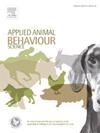Refinement of personality measures in European minks: Effect of sex, age and maternal factors
IF 2.2
2区 农林科学
Q1 AGRICULTURE, DAIRY & ANIMAL SCIENCE
引用次数: 0
Abstract
The incorporation of animal personality has been proven to enhance animal welfare and conservation programs. However, there is a need of refinement of its methodology and more research on its plasticity. We investigated European mink personality at a Spanish conservation center using behavioral coding (control and novel object tests) and caregiver trait ratings (questionnaires). Mink behavior was assessed through individual focal sampling with 1–0 time recording and using four novel objects. We examined differences by age, sex, and maternal lineage or litter effects. Findings showed good interrater reliability for seven of nine adjectives and significant correlations with behavioral measures, validating the method. More aggressive minks were generally more active, exited the nest box sooner, and approached and manipulated novel objects more quickly. Minks showed particular interest in one object (a red frisbee), indicating the need for careful consideration of object characteristics. Sex and age impacted personality traits. Males approached and manipulated novel objects sooner and more frequently than females. Adults exited the nest box sooner, exhibited greater locomotion, and approached and manipulated novel objects sooner and longer than subadults. Females were rated as more intelligent than males, adults more intelligent than subadults, with adult females scoring highest for intelligence. Results suggest potential maternal and litter effects on personality, emphasizing the need for further research. Overall, we detected some areas to further explore and give some suggestions to enhance the application of personality research into conservation programs of this critically endangered species.
求助全文
约1分钟内获得全文
求助全文
来源期刊

Applied Animal Behaviour Science
农林科学-行为科学
CiteScore
4.40
自引率
21.70%
发文量
191
审稿时长
18.1 weeks
期刊介绍:
This journal publishes relevant information on the behaviour of domesticated and utilized animals.
Topics covered include:
-Behaviour of farm, zoo and laboratory animals in relation to animal management and welfare
-Behaviour of companion animals in relation to behavioural problems, for example, in relation to the training of dogs for different purposes, in relation to behavioural problems
-Studies of the behaviour of wild animals when these studies are relevant from an applied perspective, for example in relation to wildlife management, pest management or nature conservation
-Methodological studies within relevant fields
The principal subjects are farm, companion and laboratory animals, including, of course, poultry. The journal also deals with the following animal subjects:
-Those involved in any farming system, e.g. deer, rabbits and fur-bearing animals
-Those in ANY form of confinement, e.g. zoos, safari parks and other forms of display
-Feral animals, and any animal species which impinge on farming operations, e.g. as causes of loss or damage
-Species used for hunting, recreation etc. may also be considered as acceptable subjects in some instances
-Laboratory animals, if the material relates to their behavioural requirements
 求助内容:
求助内容: 应助结果提醒方式:
应助结果提醒方式:


